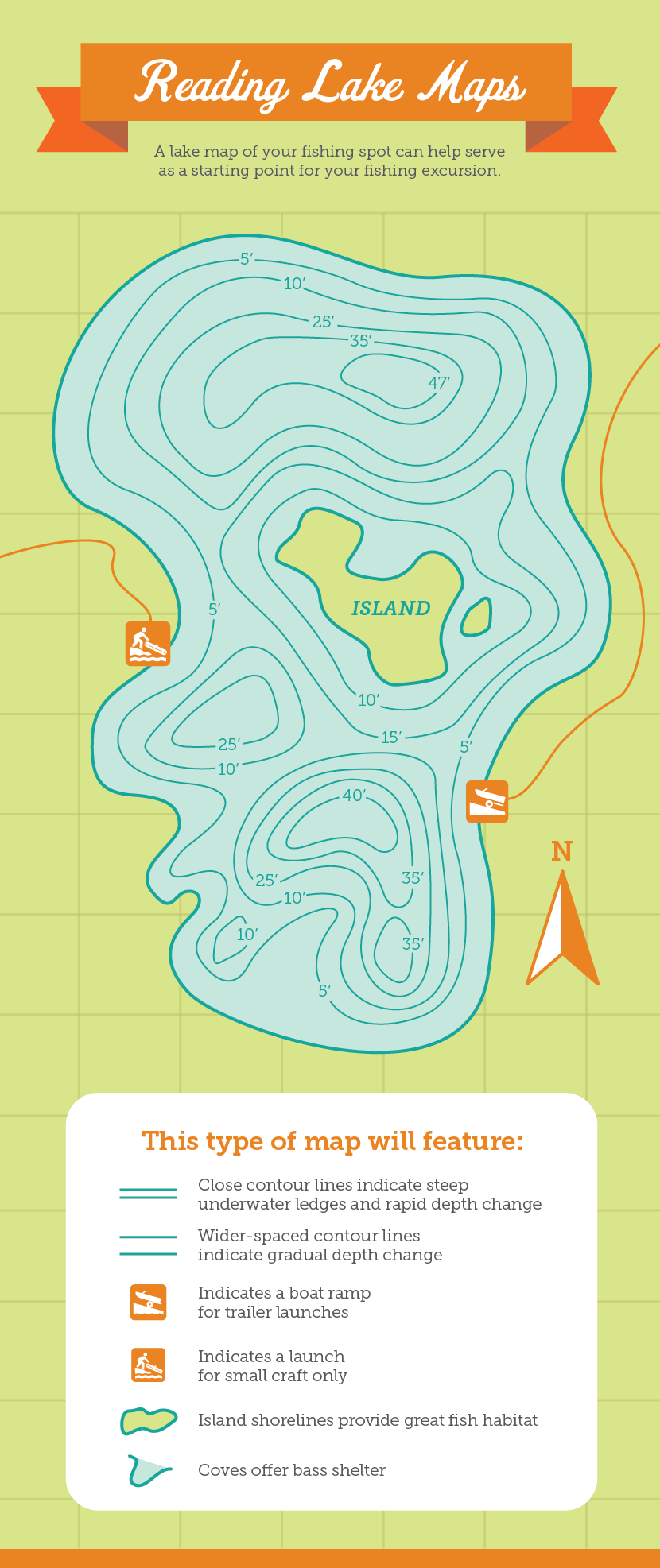Fishing 101:
Locating Bass All Season Long in Unfamiliar Lakes
Most small ponds and lakes can be fished with some level of success by the persistent angler with a minimal amount of research or scouting before the trip.
But when you want to fish that big lake everyone talks about, it pays to do a little research.
In this article, we are going to discuss using lake maps, water temperature, and time of season to help you narrow down the best areas to start fishing for bass on a large lake that you’re unfamiliar with.
We’re going to assume you don’t have a high-tech HD sonar unit to rely on, an expensive bass boat, or anything new and shiny at all.
All you need is a lake map, a compass, a good thermometer, and a good pair of polarized sunglasses.

Lake maps come in all varieties. If you’re lucky, you can find a good-quality navigational map either from NOAA or your local marina.
Navigational maps are often very detailed and will show you lots of underwater structures that tend to attract fish.
They will also show you the more subtle depth changes of the lake, which can be a huge benefit if you don’t have sonar.
If a navigational map isn’t available, then you can most likely find a lake depth map from your state agency online or in the local bait shop. You can also go online and find fishing maps of your local waterways using services like Fishidy.
In these maps, we are looking for contour lines that show lake depth.
The closer together the contour lines, the steeper the underwater drop-off.
The further apart they are, the flatter that area underwater is.
The above illustration demonstrates a generic map of your local lake that you may find online.
Even though we don’t have all the great depth lines that come with a navigational map, this is still a highly valuable tool.
Here, we want to look for areas where bass might congregate. Coves that shoot off from the main body of water offer protection from winds and currents.
Islands offer good shoreline habitat.
Most of these maps will also indicate what type of boat access is available to you, whether there’s a ramp for putting in boats with trailers or only access for small craft,
like canoes, that are hand-launched. This gives you a good starting reference.

Now that you have a general idea of a few places to boat to, water temperature and time of season are critical. Bass spawn in the springtime.
During the winter months, they generally hang out in deep water (up to 60 feet is not uncommon) and don’t feed or move a lot, since their metabolism has been slowed by the cold.
Pre-Spawn: (Water Temp 50-55° F) Water Depth 10-15 ft
Once the surface water temperature starts reaching 50-55°F, the bass will start migrating out of these deep areas and start staging in the mid-depth areas of 10-15 feet for the pre-spawn period.
Feeding will start to pick up, but it’s best to fish slow lures on the bottom at first since the bass may still be a bit lethargic.
As the water temperature increases, so will their aggression to faster baits higher in the water column.
Spawn: (Water Temp 55 – 70F, 66°F is optimal) Water Depth 0-10 ft
Once the spawn starts, it goes on in stages. Not all bass will spawn at the same time.
Any bass that are still in the pre-spawn areas will be a lot more aggressive and chase your lure.
You will probably also start seeing bass sitting on their spawning beds in shallower water.
Post Spawn: (Water Temp 70-75°F) Water Depth 0-15 ft
At this point, some bass will still be spawning, while others have moved off to other parts of the lake that offer them good opportunities to ambush bait fish.
The bass that have just spawned are usually pretty hard to catch, but will sometimes strike at something that antagonizes them, like a top water bait.
You’ll probably have better success chasing down bass that have moved to summering areas.

Summer & Fall Bass: (Water temp 75°F and up)
Now is the time to start looking for areas where the bass like to hide to ambush their prey.
Look for areas on the map that offer steep underwater ledges – these let the bass move to cooler water quickly if they need it. Look for weed beds, docks, and bridges.
Bass will hang out just outside the entrances to shallow coves if there’s a quick drop-off. Also look for any submerged trees, logs, rocks, etc.
Once the water starts cooling in the fall, bass will aggressively chase down schools of baitfish.
If you suddenly hear or see a bunch of small fish break the surface (it will sound like soda fizzing quickly),
then chances are there are some bass chasing them down. This is a good time to throw patterns that look like wounded minnows.
Fishing is as much a science as it is an art. These above methods are the same used by most touring pros, but don’t assume that your first day on the water with this knowledge will guarantee you success.
These methods will help you refine your strategy for that day, but lure selection and more are still up to you. To quote the wise angler: “If fishing was that easy, it’d be called ‘catching’!”
Embed the article on your site

